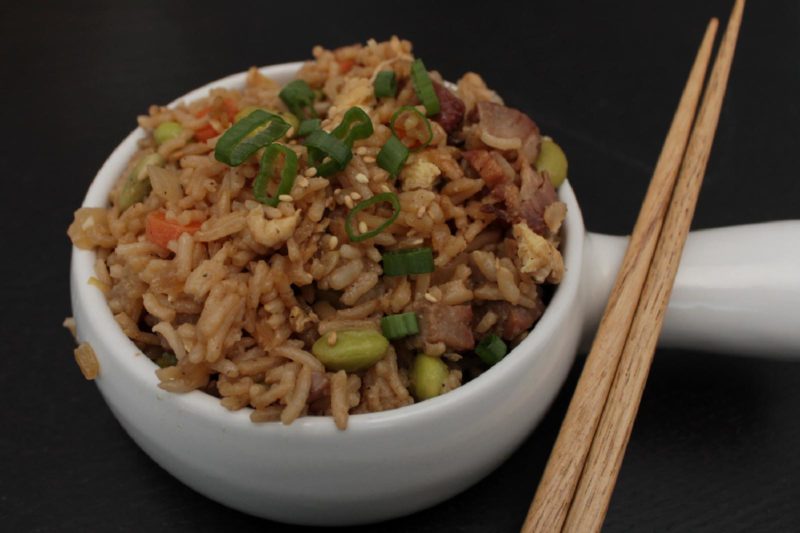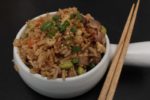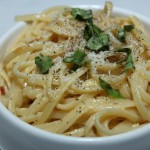I am so excited to finally have written down this simple recipe. I wing fried rice all the time, but without a recipe I get lazy and sometimes it comes out flat and uninspiring. That’s honestly one of the reasons I started a food blog — to have all of my favorite recipes in one searchable location. Seriously, I look forward to the day when I am not the vast majority of the hits on my Roasted Brussels Caesar Salad and Hibachi Noodle Bowls. (I’m there a lot. It might be a while.)
It’s fabulous to have everything in one place, because a) I <3 organization and b) I’m busy. Not as busy as some people, but I am the sort of introvert who likes periods of peace and quiet. When I lose that, I get overwhelmed fast.
Is there anyone out there who isn’t busy? Do you like it? What’s your secret? Busyness is a virtue in modern American culture, which is dumb. But I’m also relearning that when you pursue worthy goals, you have to work hard–and that includes putting in a lot of what would otherwise be free time.
On the balance, I am trying to take Sundays more or less off. The slippery slope of being unable to stop working is looming before me, but I refuse to let it get me. (Not sure yet what my success will be like; I’ll report back.)
Classic Pork Fried Rice
Fried rice is a great one for busy days. There are many ways to make fried rice; this recipe is essentially a copycat for takeout Chinese. You may have noticed that the pork in takeout rice usually has a reddish tinge–that’s cha siu, a sweet barbecued pork (I’ve used it before in Cha Siu Bao). Of course, you can sub in any protein you like.
One of the key things about stir fried rice is that “stir fry” is very literal, especially if you use a wok. Turn the heat up high and keep the ingredients moving to help them get toasty without letting them burn. That said, a saute pan works fine if you don’t have a wok. (If you’re curious about real wok techniques, check out this interview.)
Here are some general guidelines for fried rice, if you’re feeling adventurous:
- Leftover rice is perfect, as it’s less wet than fresh. I like to make extra rice for other meals and then follow it up with fried rice later in the week.
- Chicken and shrimp are also great options. Substitute stir-fried tofu to turn this into a vegetarian dish!
- Classic takeout veggies are peas and carrots, but edamame, mushrooms, and bean sprouts all work well.
- A tip from takeout: chop all the elements so they’re the size of the peas or whatever the smallest vegetable is.
- People who want to add heat can use sriracha, red pepper flakes, or sweet Thai chili sauce.
Other Methods
I’ve just talked about making fried rice, wok-style. Check out this cool guide from My King Cook on 5 Best Ways to Make Fried Rice at Home–including 15 other fried rice variations!
With assistance from this recipe.
PrintFried Rice
- Prep Time: 0 hours
- Cook Time: 0 hours
- Total Time: 20 minutes
- Yield: Serves 4 (or 3, if very hungry) 1x
Ingredients
- 2+ tablespoons oil (peanut or another oil with a high smoke point)
- 1 medium onion, chopped
- 1 cup chopped carrots
- 1 cup green peas or shelled edamame, thawed
- 1 tablespoon minced garlic
- 2 teaspoons minced ginger
- 2 eggs
- 3 cups cooked rice
- 2 cups chopped cha siu (Chinese barbecued pork)
- 4–5 tablespoons regular soy sauce
- 2 tablespoons rice wine vinegar (can substitute rice wine)
- 2 tablespoons sesame oil
- 1/4 teaspoon black pepper
- Green onions, chopped
- Sesame seeds
Instructions
- Heat 1 tablespoon of oil in a wok or large saute pan over high heat until shimmering. Cook onions and carrots until softened, about 5 minutes.
- Add peas or edamame and cook for 1 more minute. Remove vegetables to bowl.
- Crack the eggs into the wok with more oil, if needed. Scramble and cook until just done. Use the spatula to beak the egg into small pieces and remove to sit with vegetables.
- Heat the final tablespoon of oil and add garlic and ginger. Cook until fragrant, just a few seconds, and add rice. Continue stirring, breaking up any rice clumps, until the rice starts to get just a little crisp.
- Add vegetables back in, along with cha siu, soy sauce, and rice wine vinegar. Keep stirring for another minute, until the whole thing is heated through and evenly seasoned.
- Turn off heat and stir in sesame oil and pepper. Add additional soy sauce as desired.
- Mix well; served topped with green onions and sesame seeds.





